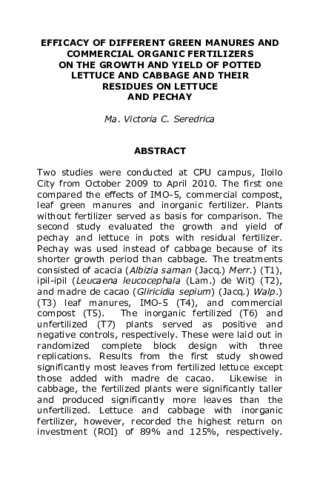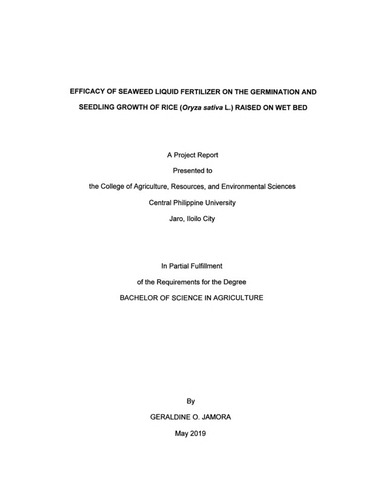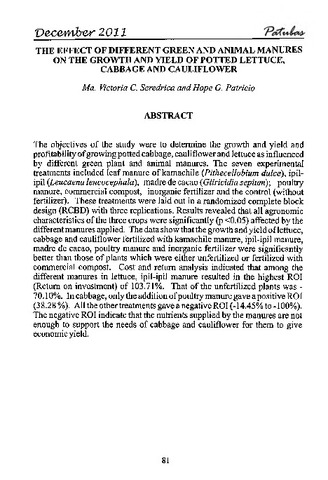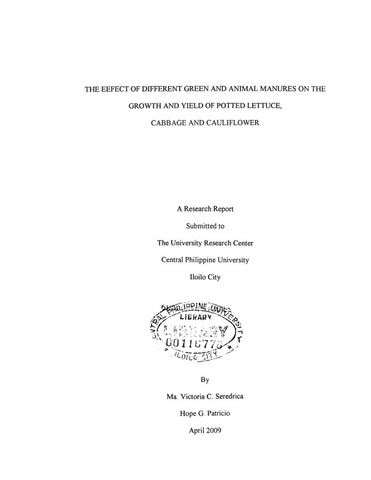Efficacy of different green manures and commercial organic fertilizers on the growth and yield of potted lettuce and cabbage and their residues on lettuce and pechay
Résumé
Two studies were conducted at CPU campus, Iloilo City from October 2009 to April 2010. The first one compared the effects of IMO-5, commercial compost, leaf green manures and inorganic fertilizer. Plants without fertilizer served as basis for comparison. The second study evaluated the growth and yield of pechay and lettuce in pots with residual fertilizer. Pechay was used instead of cabbage because of its shorter growth period than cabbage. The treatments consisted of acacia (Albizia saman (Jacq.) Merr.) (T1), ipil-ipil (Leucaena leucocephala (Lam.) de Wit) (T2), and madre de cacao (Gliricidia sepium) (Jacq.) Walp.) (T3) leaf manures, IMO-5 (T4), and commercial compost (T5). The inorganic fertilized (T6) and unfertilized (T7) plants served as positive and negative controls, respectively. These were laid out in randomized complete block design with three replications. Results from the first study showed significantly most leaves from fertilized lettuce except those added with madre de cacao. Likewise in cabbage, the fertilized plants were significantly taller and produced significantly more leaves than the unfertilized. Lettuce and cabbage with inorganic fertilizer, however, recorded the highest return on investment (ROI) of 89% and 125%, respectively. Results from the second study revealed that lettuce grown in soil with residues of green manures and commercial organic fertilizers had more leaves, were taller, and out yielded the unfertilized plants and those previously applied with inorganic fertilizer. Results further showed that pechay with different manures had statistically similar leaf count and height but had significantly outperformed those with inorganic fertilizer (T6) and without fertilizer (T7). However, lettuce and pechay with residues of compost (T5) showed the highest ROI of 411% and 318%, respectively. Based on the results of the first study, it is concluded that it is profitable to use inorganic fertilizer (T6) in lettuce and cabbage production. However, it was the residue from commercial compost (T5) that sustained soil productivity and profitability of the second crop.
Description
Journal article
Suggested Citation
Seredrica, M. V. C. (2014). Efficacy of different green manures and commercial organic fertilizers on the growth and yield of potted lettuce and cabbage and their residues on lettuce and pechay.Type
ArticleISSN
1908-515XKeywords
Collections
- Journal articles [25]
- Patubas [109]
Related items
Showing items related by title, author, creator and subject.
-
Efficacy of seaweed liquid fertilizer on the germination and seedling growth of rice (Oryza sativa L.) raised on wet bed
Jamora, Geraldine O. (2019)The experiment was conducted at the College of Agriculture, Resources and Environmental Sciences Research and Development Center, Central Philippine University, Jaro, Iloilo City on April 23 to May 13, 2019. This study ... -
The effect of different green and animal manures on the growth and yield of potted lettuce, cabbage and cauliflower
Seredrica, Ma. Victoria C.; Patricio, Hope G. (Central Philippine University, 2011-12)The objectives of the study were to determine the growth and yield and profitability of growing potted cabbage, cauliflower, and lettuce as influenced by different green plant and animal manures. The seven experimental ... -
The effect of different green and animal manures on the growth and yield of potted lettuce, cabbage and cauliflower
Seredrica, Ma. Victoria C.; Patricio, Hope G. (2009-04)The three crops were planted at different dates at three weeks interval at the back of the College of Agriculture Building. Lettuce was sown first in August 13 and harvested on October 24, 2007; Cabbage from September 4, ...






